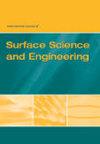Analysis of oxide scale deformation and surface roughness characterisation in hot rolling of stainless steels
IF 1.2
4区 工程技术
Q4 ENGINEERING, MECHANICAL
International Journal of Surface Science and Engineering
Pub Date : 2017-08-04
DOI:10.1504/IJSURFSE.2017.085623
引用次数: 0
Abstract
Stainless steels are iron-based alloys that contain a minimum of about 12% Cr. They have been classified by microstructure at room temperature. Two stainless steel grades 304 and 410L were studied in this paper. Hot rolling was performed on a Hille 100 experimental rolling mill under various reductions with consideration of the oxide scale thickness controlled by oxidation time. The experimental results show that the deformation behaviour of the oxide scale on the stainless steel 304 is sensitive to its thickness and exhibits higher resistance to be deformed. However, the reduction in thickness plays an important role in the uniformity of the oxide scale deformation for the stainless steel 410L. Friction coefficients were calculated and compared. Simulations results show that the reduction in thickness and initial surface roughness play roles on final surface roughness. Steel substrate surface is rougher than that of the oxide scale at different reductions.不锈钢热轧氧化皮变形及表面粗糙度特征分析
不锈钢是含铬最少12%的铁基合金,根据室温下的微观结构进行分类。本文对304和410L两种不锈钢进行了研究。在考虑氧化时间控制氧化皮厚度的条件下,在Hille 100实验轧机上进行了不同还原度的热轧试验。实验结果表明,304不锈钢表面氧化皮的变形行为对其厚度敏感,且具有较高的抗变形能力。而厚度的减小对410L不锈钢氧化皮变形的均匀性起着重要的作用。计算并比较了摩擦系数。仿真结果表明,厚度和初始表面粗糙度的减小对最终表面粗糙度有影响。在不同的还原度下,钢基体表面比氧化皮表面粗糙。
本文章由计算机程序翻译,如有差异,请以英文原文为准。
求助全文
约1分钟内获得全文
求助全文
来源期刊
CiteScore
1.60
自引率
25.00%
发文量
21
审稿时长
>12 weeks
期刊介绍:
IJSurfSE publishes refereed quality papers in the broad field of surface science and engineering including tribology, but with a special emphasis on the research and development in friction, wear, coatings and surface modification processes such as surface treatment, cladding, machining, polishing and grinding, across multiple scales from nanoscopic to macroscopic dimensions. High-integrity and high-performance surfaces of components have become a central research area in the professional community whose aim is to develop highly reliable ultra-precision devices.

 求助内容:
求助内容: 应助结果提醒方式:
应助结果提醒方式:


